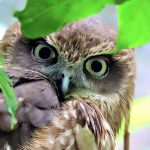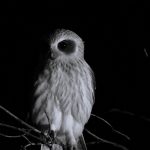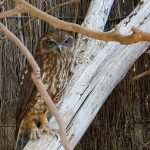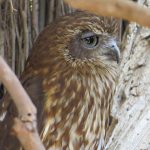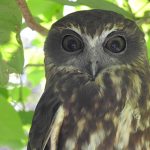AUSTRALIAN BOOBOOK
The Night’s Soft-Spoken Watcher
As twilight paints the Australian bush in shades of indigo and silver, a gentle, rhythmic call begins to echo from the tall eucalypts: “boo-book… boo-book.” This is the voice of the Australian Boobook —a remarkable owl that thrives across much of Australia and its neighbours, quietly weaving itself into our nightly landscapes.
Portrait of the Boobook
Appearance
The Australian Boobook stands as a medium-sized owl, measuring between 30 and 36 centimetres in length. Its:
- Soft brown plumage is intricately mottled with streaks and spots, creating a tapestry of lighter and darker shades.
- This camouflage allows it to virtually disappear against the textured bark of towering gums or dense foliage, providing safety from both predator and prey during daylight hours.
Imagine approaching this owl’s resting place:
- The air is cool, tinged with the earthy scent of leaf litter.
- Sunbeams slice through the canopy, dappling the owl’s feathers with shifting patterns.
- The Boobook’s large, inquisitive eyes—framed by a facial disc—follow each movement with silent curiosity.
Home Among the Trees
Habitat
The adaptability of the Australian Boobook is truly extraordinary. You may encounter them in:
- Dense forests where the understorey is teeming with insect life,
- Open woodlands dotted with worn, hollow trees,
- Coastal shrublands where sea breezes ruffle their feathers,
- Parks and urban gardens, where their presence often goes unnoticed by day but is betrayed by their haunting nocturnal song.
Urban Encounters
It is not uncommon for suburban residents to hear the Boobook’s call rippling through city parks or quiet backyards after sunset. This proximity to human settlement highlights the resilience and adaptability of these owls, yet also underscores the need to protect urban green spaces.
Rhythm of the Night
Nocturnal Lifestyle
The Boobook is predominantly nocturnal, coming alive as the world grows quiet. With incredible hearing and silent flight, it hunts:
- Insects—beetles, moths, and grasshoppers
- Small mammals—mice and occasionally bats
- Birds—unwary roosting birds
- Reptiles—on rare occasions
The Hunt
The stillness of night is occasionally punctuated by the faint rustle of wings, a soft landing on a branch, or the quiet snap of a beak.
Voice in the Darkness
Iconic Call
The Boobook’s famed “boo-book” or, on some islands, “more-pork” call, is both a territorial announcement and a way to find a mate.
- Male and female Boobooks sometimes call together in a duet, the female’s tones just slightly higher.
- In the hush of winter nights, these calls become steady and persistent, marking the approach of breeding season.
Circle of Life
Breeding and Family
- Breeding Season: August to December, aligned with the abundance of spring life.
- Nesting: Boobooks favour tree hollows or natural cavities—habitats formed by centuries-old trees.
- Eggs and Chicks: Typically 2–3 eggs are laid. The female incubates them, her presence virtually undetectable thanks to her camouflage.
- After about a month, downy chicks hatch and remain within the nest until they are ready to fledge, learning the ways of the night under the watchful eyes of their parents.
Diversity Across the Land
Subspecies and Variation
Unlike many birds, the Australian Boobook exhibits regional variation. Adaptations in size, plumage, and behaviour allow it to thrive from humid rainforests to arid inland forests. Some populations on nearby islands differ slightly, contributing to the rich tapestry of Australia’s nocturnal wildlife.
Are the Australian Boobok and the Southern Boobok the Same Bird?
The term Boobok generally refers to the Ninox genus of owls, and specifically, the species:
- Ninox boobook
Commonly known as the Australian Boobook or Southern Boobook.
Taxonomy Table
| Common Name | Scientific Name | Region |
|---|---|---|
| Australian Boobook | Ninox boobook | Australia-wide, southern regions |
| Southern Boobook | Ninox boobook | Southern Australia, New Zealand (introduced) |
Are They the Same?
Yes, the Australian Boobok and the Southern Boobok usually refer to the same species:
Ninox boobook.
- The name “Southern Boobok” is often used to distinguish this species from closely related boobooks found in northern Australia or on nearby islands.
- “Australian Boobok” is a broader term but is used interchangeably in many field guides and scientific literature.
Guardianship of the Night
The Australian Boobook’s story is a reminder of the delicate balance that sustains our natural world. While they adapt well to urban life, their dependency on old trees with hollows for nesting underlines the importance of conserving ancient woodlands and providing green spaces—even in towns and cities.
| Fact | Details |
|---|---|
| Scientific Name | Ninox boobook |
| Average Length | 30–36 cm |
| Diet | Insects, small mammals, birds, reptiles |
| Habitat | Forests, woodlands, shrublands, urban areas |
| Distinctive Call | “boo-book”, “more-pork” |
| Breeding Season | August–December |
| Nesting Sites | Tree hollows, natural cavities |
Bringing the Boobook Closer to Home
Next time dusk falls, listen carefully for the resonant calls drifting through the air. The Australian Boobook is not merely an owl of legend, but a living ambassador for Australia’s night, inviting us to cherish and protect the wild spaces that sustain these silent hunters.
By understanding, respecting, and preserving their habitats, we can ensure that the soft calls of the Boobook continue to enrich Australian nights for generations to come.

